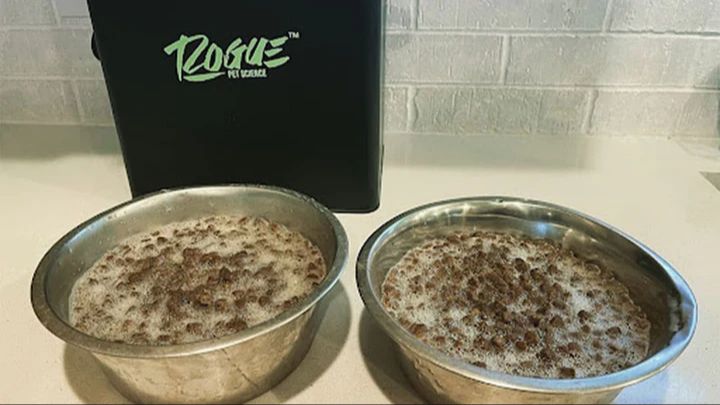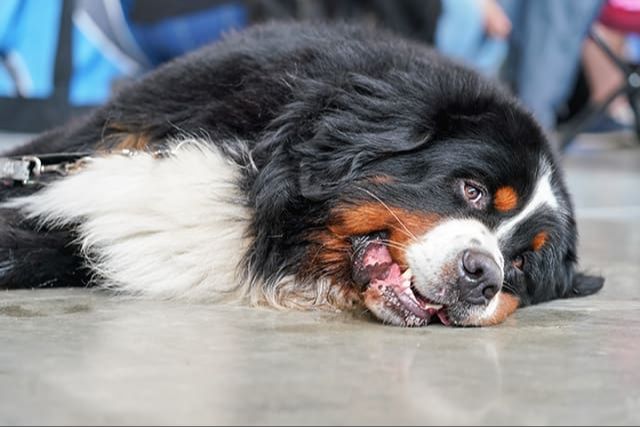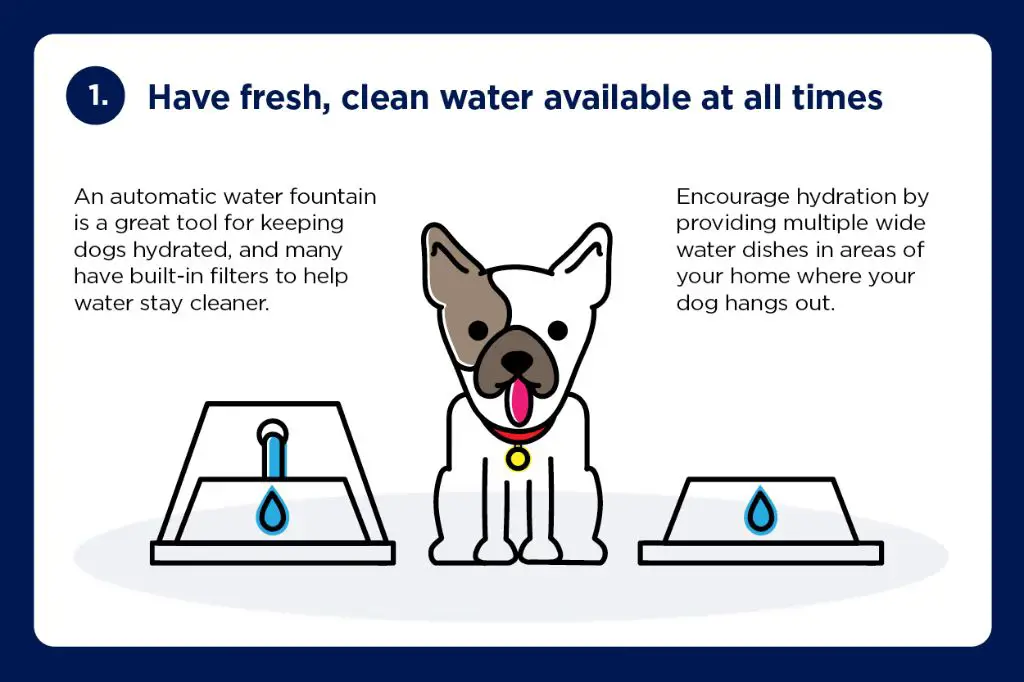Introduction
Adding water to dry dog food is a common practice among dog owners. Some people believe it helps improve hydration and makes the food easier to eat. Others argue that it can dilute nutrients and cause digestive issues. So should you add water to dry dog food or not?
In this article, we’ll explore the key considerations around adding water to dry dog food. We’ll look at the potential benefits and downsides, examine how much water you should add, and discuss when you might want to add water versus other alternatives. We’ll also provide tips on keeping your dog hydrated overall. By the end, you’ll have a better understanding of whether or not adding water to your dog’s dry food is advisable.
Pros of Adding Water
Adding water to dry dog food can provide some benefits for your pup. Here are a couple of the main pros of adding water:
Makes Food More Palatable
Dry kibble can often be boring and unappetizing for dogs to eat plain. Adding some water to turn the kibble into a broth can make the food more enticing and palatable. The gravy enhances the smell and flavor, which encourage picky dogs to eat.
Provides Extra Hydration
Adding water to the kibble gives your dog extra fluid intake with their meal. This can help supplement their overall daily water consumption. Getting enough water is critical for dogs’ health and digestion. Since hydrating kibble allows dogs to take in moisture as they eat, it can aid hydration and contribute to meeting their daily water needs.
Cons of Adding Water
While adding water to dry dog food may seem harmless, there are some potential downsides to keep in mind:
Dilutes nutrients/calories – Dry dog food is designed to provide complete and balanced nutrition when fed as directed by the label. Adding water can dilute the calorie density and nutrient composition, essentially “watering down” the food. This is especially problematic for high-energy dogs or those needing a nutrient-dense diet.
Risk of bacterial growth if left out – Wet food left out at room temperature provides an ideal environment for bacteria to multiply quickly. Only add as much water as your dog will consume in one meal. Leaving wet food out for prolonged periods allows bacteria to grow to unsafe levels, putting your dog at risk of gastrointestinal illness.
How Much Water to Add

The amount of water to add to your dog’s dry food depends on several factors, including their size, age, and activity level:
– For puppies, add around 1/2 – 1 cup of water per 1 cup of kibble. Puppies have small stomachs so need soft, moistened kibble.
– For adult dogs, start by adding 1/4 – 1/2 cup of water per 1 cup of kibble. Monitor if your dog needs more water added as each dog is different.
– Senior dogs may need more water added, around 1/2 – 3/4 cup per 1 cup of kibble. Keeping the kibble soft makes it easier to chew.
– Highly active dogs like working or sporting breeds often need more water added to keep them hydrated.
– Always follow package guidelines for amounts to add. Start conservatively and increase as needed.
– Adding too much water can make the kibble fall apart into mush. Monitor consistency and adjust water amounts accordingly.
When to Add Water
The best time to add water to your dog’s dry food is right before mealtime. Adding water too far in advance can cause the kibble to become soggy and unappetizing. Aim to add water within 10-15 minutes of when you plan to feed your dog.
Don’t add water hours in advance – this will cause the food to absorb too much liquid, become mushy, and lose its crunch. The texture change can put some dogs off their food. For the best results, add just enough water to moisten the kibble slightly before immediately serving.
You can add warm or cool water. Some dogs prefer warm water, which can enhance the aroma and palatability of the food. Other dogs like cold water instead. Observe your dog’s preference.
Get into a routine of adding water right before you set your dog’s bowl down. This timing optimizes the food’s texture and moisture level. Adding water too early ruins the kibble’s crunch.
Alternatives to Adding Water
If you don’t want to add water to your dog’s dry food, there are some alternatives to consider:
Switch to Wet Food
Wet or canned dog food already has a high moisture content of around 75%, compared to only 10% for dry kibble. Switching your dog to a wet food diet is an easy way to increase their hydration without having to add water separately.
Use Broths or Gravies
There are special dog broths and gravies available that can be poured over dry food to increase palatability and moisture. These are often sold alongside dry kibble and provide an easy way to add more flavor and fluids.
Provide Fresh Water
Simply ensuring your dog always has access to fresh, clean drinking water is the best way to keep them hydrated. Make sure their water bowl is kept full and washed regularly.
Signs Your Dog Needs More Hydration

There are a few telltale signs that indicate your dog may need more hydration:
Dry Nose/Eyes
Dogs’ noses and eyes should always be moist. If you notice your dog’s nose is dry and cracked or their eyes seem dry, it could be a sign of dehydration. Healthy dogs have wet noses and bright eyes.
Lethargy
If your dog seems more tired than usual and has low energy levels, it may be due to dehydration. When dogs don’t get enough fluids, they can become lethargic and lack the pep in their step. Increased sleepiness or moving slower on walks may indicate they need more water.
Yellow Urine
Pay attention to the color of your dog’s urine. Properly hydrated dogs will have light yellow to clear urine. Dark yellow urine is concentrated, meaning your dog needs more water. If their urine is brown, take them to the vet immediately as this can signal liver or kidney problems.
Tips for Keeping Your Dog Hydrated

There are several easy ways to make sure your dog stays properly hydrated without having to add extra water to their dry kibble:
-
Provide fresh water at all times – Keep their water bowl full of clean, fresh water that is easily accessible. Change the water daily.
-
Add water to food – While not always necessary, adding some water to your dog’s kibble can help increase their fluid intake.
-
Offer ice cubes – Many dogs love chewing on ice cubes. Just be sure they don’t attempt to quickly swallow large pieces whole.
-
Feed wet food – Canned dog foods have a high water content and can add extra hydration.
-
Use a fountain or bottle – Pet water fountains keep water circulating and fresh. Bottled water dispensers allow access without spilling.
Following these tips can help ensure your dog gets enough fluids each day, even without adding water to their dry food.
Ask Your Vet

When in doubt, consult your veterinarian about whether adding water to your dog’s dry food is recommended. Your vet knows your dog’s specific health conditions, activity level, and other factors that determine hydration needs. Get personalized advice tailored for your dog’s diet, age, breed, and any medical issues.
Veterinarians can evaluate if your dog is getting enough fluids and is properly hydrated. They may recommend adding water or broth to your dog’s meals, suggest wet food instead of dry, advise on optimal water bowl settings, and provide tips for keeping your dog hydrated. Your vet can also rule out any underlying medical conditions causing increased thirst or dehydration. Don’t guess – ask your vet for the best guidance on hydrating your furry friend.
Conclusion
Deciding whether or not to add water to your dog’s dry food depends on a variety of factors, including your dog’s hydration needs and preferences, as well as the food’s texture and nutritional profile. While adding some water can make dry food easier to chew and digest, too much can dilute nutrients and create an unappetizing mush. Focus on keeping your dog properly hydrated overall with fresh water available at all times. Monitor their energy, health, and stool consistency. Consider options like wet food, broths, or dental/hydration aids if your dog struggles with dry food. Ultimately, the decision to add water comes down to your dog’s unique needs and what works best to keep them healthy and happy.
In summary, adding a small amount of water to dry dog food can be beneficial, but too much water can negatively impact the food. Keep a close eye on your dog’s hydration, and consider alternatives if they don’t seem to tolerate dry food well. When in doubt, check with your veterinarian for personalized advice on diet and hydration for your pup.